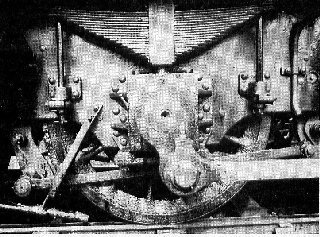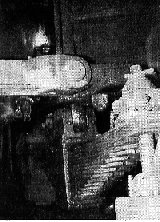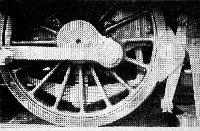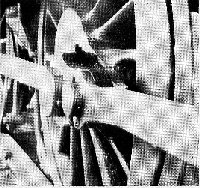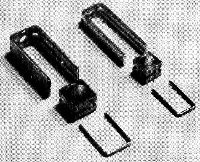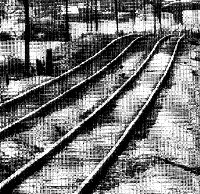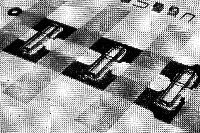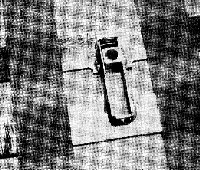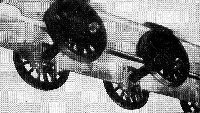In rigidly-suspended models, the
slightest unevenness in the track will cause individual wheels to lift from the rail;
although this lifting may not be detected by the eye, it nevertheless means that no more
than three wheels, two on one side and one on the other, can be guaranteed to be in firm
contact with the rail at any particular moment, and therefore that the full traction
potential of the model can never be realised.
The almost universal use of 'two-rail' power feed to
locomotive models requires constant electrical contact to be maintained. As the continual
intermittent lifting of rigidly-suspended wheelsets causes 'making and breaking' of these
contact points, the flow of power is likely to be irregular and the ideal conditions for
the accumulation of wheel tread deposits are created.
In view of the above, it is difficult to avoid the
conclusion that the optimum model performance and the correct representation of the
prototype are simultaneously achieved through the use of spring suspension of the
locomotive upon its wheelsets.
Many attempts have been made by manufacturers and
modellers to disguise the undesirable effects of rigid suspensions, most of which have
provided more problems than they solve. They range from overscale wheels and flanges,
which bring distorted track settings with them, through rubber and plastic wheel tyres, to
that pathetic track-clinger, magnetic adhesion'. It is therefore all the more curious that
while manufacturers and modellers have been busily trying to treat the symptoms of the
rigid suspension system and learning to ignore the terrible side-effects few attempts have
been made to cure the disease.
With the appearance of Protofour a completely new
approach to the matter of locomotive suspension became imperative. When the MRSG designed
the Compensated Suspension Unit for Carriage and Wagon conversion, the resulting quality
of running made the continued acceptance of previous suspension systems impossible. The
MRSG therefore listed the desirable features of a prototypical locomotive suspension, as
follows:
1. Compensation of all wheels.
2. Scale appearance.
3. Simplicity of assembly.
4. Adaptability of use.
5. Accessibility of components.
6. Minimal cost.
7. Minimal maintenance.
8. Continuous electrical contact between rail and motor.
9. Quiet running.
The components involved in the design were listed
as:
1. Mainframes,
2. Mainframe spacers.
3. Hornblocks.
4. Bearings.
5. Springs.
7. Coupling rods.
8. Bogies and Trucks.
9. Electrical Pickup Gear.
10. Transmission.
11. Motor,
In designing these parts it quickly became apparent
why no similar system had appeared - each part is dependent upon all of the others. Every
component must be designed twice; firstly to fulfil its function, and secondly to
integrate with the others. Once a dimensioning chain is established it is necessary to
work back again to ensure that parts are held to scale dimensioning. However, the
operation is resolved with care and concentration, and as most of the listed parts have
prototype equivalents, it is logical to commence with an examination of the layout of a
steam locomotive, which is, after all, what we are supposed to be representing in our
models.
British steam locomotive mainframes are normally cut
from 1in -1¼in, steel plate. They incorporate slots to clear the axles and to reduce
weight and are predrilled to mount components such as the cylinders, motion brackets and
brake hangers, and are contoured to strengthen potentially weak locations. Spacers serve
to hold the otherwise flexible frames rigidly at the correct distance apart and the
components within the frames in correct alignment.
Hornblocks are heavy, cast flanges mounted over the
axle slots to form vertical slideways in which the axle bearings may ride. Their heavy
construction is necessary to enable them to accept the force of the pistons and other
running and braking forces.
Bearings are fitted over the axle journals and
consist of an inverted 'U' containing a semi-circular bearing surface, to which is
attached an oil reservoir with wicks to transport the oil to the axle journals. The
bearing has a square external form with flanges which fit over the vertical hornblock
slideways. The hornblocks thus position the wheelbase both longitudinally and laterally in
the frames.
Springs are generally of the multiple leaf type with
their ends retained in hangers fixed to the frame and with the centre strap attached
directly to the bearing. Some designs featured coil springs in place of the leaf type, and
others, particularly those with bar frames as in America and Europe, incorporated
compensating beams.
Wheelsets are familiar to modellers as they are
easily examined in photographs. How ever,the treatment of the rear faces may vary, some
designs having concave taper and a recessed boss, and some, as in the NCC Broad Gauge
locomotives, having the wheel reversed so that the front taper brings the tyre to the
desired gauge,
Coupling and connecting rods are precision-machined
to the axle spacings. Their end knuckles,which contain the bearing surface for the
crankpins, are about twice the height and width of the rod itself. Some designers
preferred rods milled to 'I' section but these are not so stiff as the plain rectangular
section, as BR's 'Britannias' proved by bending several.
Bogies and Trucks are miniature frames which rotate
about a pivot and are permitted, limited, controlled sideplay relative to the frames. They
contain miniature hornblocks and springs and retain wheelsets just as in the mainframes,
but their lateral movement adjusts the wheelset radially to the track and allows the
locomotive's wheelbase to flex at its extremities. A similar effect is obtained through
the use of radial' axleboxes in which the hornblocks are machined radially and the
wheelset with its bearings traverses an arc.
In translating full-sized practice to model
operations, the following features need to be noted:
1. Wheels are permanently fitted to their axles to
form wheelsets and are gauged, quartered and fitted with crankpins before are mounted in
the frames.
2. The wheelset is fitted with bearings and the latter introduced into the hornblocks,
where the wheelset rides vertically under the influence of the springs. A strap across the
hornblock ends prevents the wheelset from falling out of the mainframe when the locomotive
is lifted.
3. Axle-to-bearing, and bearing-to hornblock surfaces are generous, as they have to be to
accept the forces and pressures involved. Sound engineering practice suggests that the
length ofthe bearing should not be less than its diameter.
4. There is no vertical movement of the bogie relative to the mainframe, all movement of
the wheelsets taking place in the hornblooks. The bogie carries the locomotive weight on
pads formed in the upper surface, which allow the bogie to slide laterally relative to the
frame. The side control springs act on a bolster attached to the central pivot, so that
the bogie moves relative to the bolster. Inadequate lubrication of these sliding surfaces
may have been a contributing factor in the high-speed derailment of a LSWR boat train in
Salisbury station, back in 1906.
5. Bogie wheelsets are generally sprung by means of a single longitudinal spring on each
side of the bogie. This is not easily seen as it is carried in the inverted position
between two plates ofa hollow beam. The centre strap is attached to the bogie frame, the
ends of the spring are attached to the beam, and the beam in turn curves upwards to enter
the tops of the hornblocks to bear on the bear ings. There is thus a combined springing
and compensating action.
|
